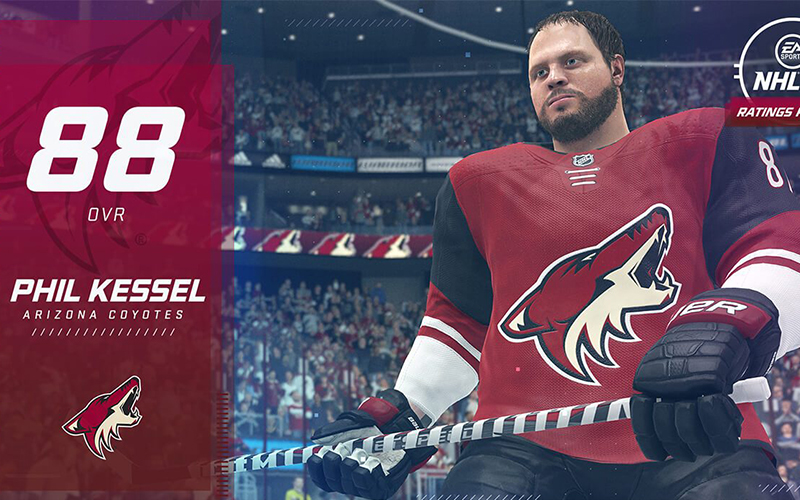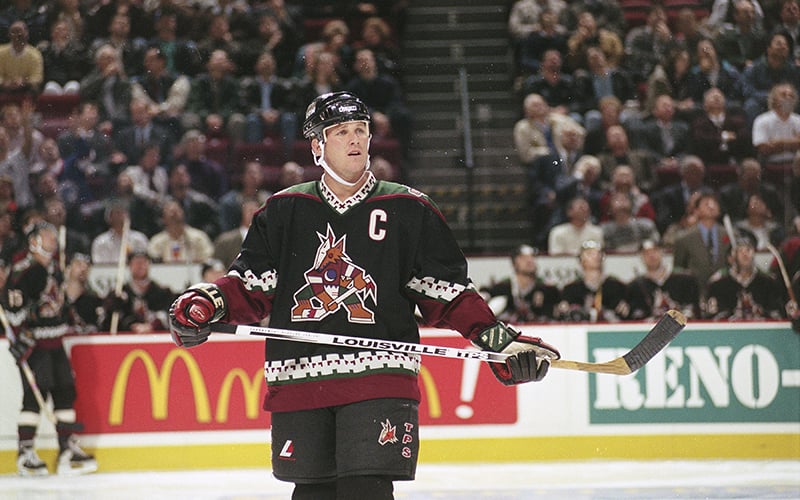
The Arizona Coyotes are live-streaming virtual games on their YouTube, Facebook and Twitch accounts with the help of the NHL 20 video game. (Photo courtesy of EA Sports)
PHOENIX – On Tuesday, March 31, despite a raging pandemic, the Arizona Coyotes live-streamed their game against the Colorado Avalanche on their YouTube, Facebook and Twitch accounts.
Like every other Coyotes broadcast, it started with pregame analysis from play-by-play broadcaster Matt McConnell and analyst Tyson Nash, with both emphasizing how critical the game was to the Coyotes’ postseason push.
When the puck dropped, the broadcast unfolded with McConnell and Nash describing the action and the Coyotes social media team live-tweeting highlights and game graphics
Of course, the game didn’t really happen.
This one was played on virtual ice, simulated on “NHL 20,” the popular EA Sports hockey video game.
It substituted for the critical matchup that would have really happened that night had it not been for the COVID-19 outbreak that led the NHL and every other pro sports league to shutdown in an effort to prevent spread of the coronavirus.
With no real game, the Coyotes pivoted, giving their fans a virtual taste of a playoff push.
“The Coyotes put it together pretty quickly,” McConnell said. “I think it’s a way to stay connected with fans, have fun and get some familiar voices back out there. After the first one we did (a Coyotes-Red Wings game March 20), the response was overwhelmingly positive.”
The point for the Coyotes is to make the games feel as real as possible. More goes into the production than just picking the teams and letting the game run its course.
“Even the AI in the gameplay should set us apart,” said Kevin Thompson, the team’s motion graphics coordinator. “We use custom in-game settings that make the action look as real as possible. Both teams are set to the same difficulty, too; we’re not cheating. We don’t know how the game will end. So far, the settings have given us hat tricks and game-tying goals which lead to overtime thrillers.”
The Coyotes altered the skating settings so that players are not zipping down the ice like the Looney Tunes Road Runner (a noted Coyote nemesis). They changed how often penalties are called based on real games this season, adjusted how players shoot and other gameplay sliders.
Then the team gets to work on recreating a normal television broadcast.
“We made all the graphics and after effects, tried to copy all the camera angles and we used our star broadcast team,” Thompson said. “They’ll put together a pregame and postgame and they do play-by-play with the same enthusiasm of a real game, which is nuts.”
They even have postgame interviews with players who performed well in the simulated game. After a virtual game against the Las Vegas Golden Knights, analyst Paul Bissonnette interviewed Carl Soderberg, whose “NHL 20” virtual counterpart scored a hat trick during the game.
The “NHL 20” games also allow the team to showcase real sponsors.
After the Coyotes posted their first game, they reached out to sponsors like the fast-food giant Taco Bell.
Now, the same Taco Bell promotions featured in real games are playing out in the video-game version. For instance, if the Coyotes score a goal in the third period, fans are treated to free tacos the next day, just as they were during real games.
So far, the virtual games are a hit.
The first “broadcast” was viewed more than 12,000 times on YouTube, with hundreds more watching it on social media. And fans are engaged.
“We’re seeing a ton of engagement on social media which sometimes matches or even beats out real games,” Thompson said.
For the second game, the Coyotes launched an official Twitch account and streamed a matchup with Las Vegas there and on other social-media platforms. During that broadcast, the team’s mascot Howler jumped on his official Twitch account to interact with fans.
YouTube views dropped, but Thompson said that is because fans spread their love around to other platforms such as Twitch and Twitter.
Putting together the broadcast requires a lot of collaboration and creativity, given that everyone involved is participating from home.
McConnell recorded the call for the virtual Detroit game in his house using a Zoom, the video-conferencing application that has become go-to technology during the pandemic.
McConnell’s idea for the second “NHL 20” streaming broadcast was even more inventive.
“For the second one, I sat in the car,” McConnell said. “It was the only quiet place in the house. I set up my phone on the headrest of the front seat and called the game. Then I sent a few audio files. They (producers) then matched the action with the audio. The social team handles getting it out, and they do a great job.”
The Coyotes are among several NHL teams bringing fans games via video games. NBC Sports Washington is even broadcasting its simulated Capitals games on television.
In the Valley, the Phoenix Suns have been streaming virtual games on Twitch with different players or celebrities controlling the teams in “NBA2K” video-game matchups. On March 27, Jon Bloom called the play-by-play and analyst Tim Kempton provided color during a virtual game won by the Suns with Mikal Bridges on the sticks against Philadelphia’s Matisse Thybulle.
For the Coyotes, the games are a great way to engage fans and give sponsors something in return for their support. And they give the club’s social-media team something to get excited about.
“There’s a lot of ideas we have, this is a great way to combine everyone’s efforts while we’re in this pause,” Thompson said. “There’s a lot more enthusiasm for a project like this than other nonessential things during a pause.”
In a time of crisis, there are more pressing matters than filling up sports arenas. But with their game streams, the Coyotes have found a way to keep fans jumping off the couch to celebrate goals and spectacular saves using a little technology and creative thinking.

